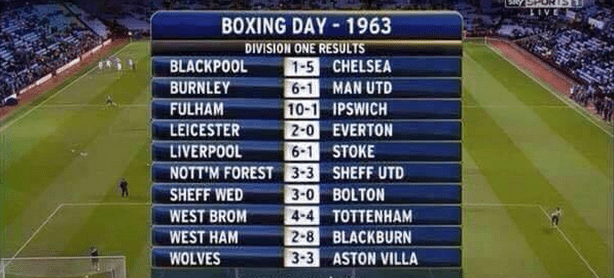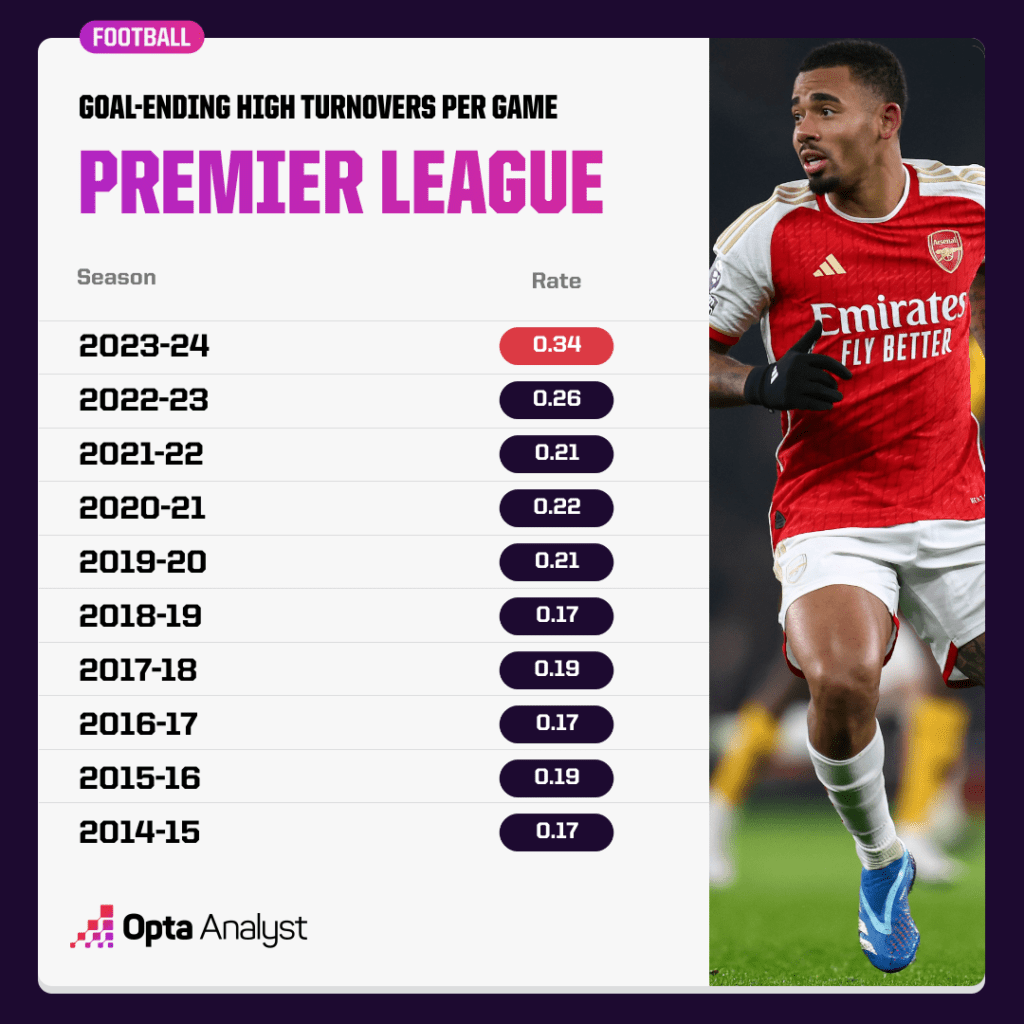With more goals being scored than ever before in the Premier League, we take a look into the numbers and look at some potential reasons for the rise in goals and entertainment.
The six-goal thriller played out by Manchester City and Tottenham on Sunday afternoon was nothing we shouldn’t have expected. It was the culmination of a day of incredible Premier League action, in a season of goals, goals, and more goals; more than we’ve ever seen before in the Premier League, in fact.
The five games played on Sunday produced a whopping 24 goals, taking the average in the top flight in 2023-24 to 3.16 per game – higher than in any other Premier League campaign and the most in the top flight since 1964-65, back in an era when the First Division produced infamous days like this:

And it hasn’t just a been small increase this season. This is the first time the seasonal average has been above 2.85 goals per game since the 1960s. And it’s way over that.
There wasn’t a single clean sheet on Sunday; Premier League games have averaged 0.4 clean sheets per game this season, the lowest rate ever seen in the Premier League era and the lowest in the top flight since 1961-62.
Premier League games are producing more entertainment than ever. This glut of goals follows a trend over recent years that is also being seen further down the divisions. Both the Championship and League Two are seeing a higher rate of goals per game than in any other season in any recent decade.

Of the top four tiers, only League One hasn’t seen a dramatic uptick in goals scored, with its 2023-24 rate of 2.54 goals per game bucking the trend, lower even than the division’s rate last season (2.56).
So, what’s the reason for all this entertainment in the Premier League? (And yes, we’re here to dig into, analyse and suck the fun out of the numbers, rather than just sit back enjoy the increase in goals.)
First of all, professional football is simply more attacking these days. Right down the pyramid in England, it is increasingly the norm for teams to play possession football, to look to dominate the ball and assert themselves rather than sit back, soak up pressure in the hope of shutting the opposition out and potentially nick something on the break. Even as low down as League Two, there are plenty of teams who look to play this way, and in the Premier League almost every team will do.
This type of football has also been coupled with more teams pressing high up the pitch – front-foot defending to go with front-foot possession-based football – and the standard of pressing in the Premier League increasing, too. With teams encouraged to take more risks on the ball and opponents pressing more willingly, we are seeing more high turnovers per game (16.5) than in any other Premier League season on record (since 2010-11).
It follows that we are also seeing more high turnovers which lead to a goal scored (0.34 per game) than in any other Premier League campaign. There’s only ever been one season in which that rate has been above 0.25 per game (0.26 last season), with most seasons averaging between 0.1 and 0.2 goal-ending high turnovers per game. In other words, that rate has as good as doubled this term compared to most recent campaigns.

One of the main explanations for the added entertainment, however, has been the increase in playing time as a result of the refereeing directives to crack down on time-wasting. We are seeing more time added on to matches than ever before, and a significant increase in ball-in-play time, as a result.
Premier League matches are, on average, three minutes and 21 seconds longer than last season, while games in the Championship, League One and League Two are each around two minutes longer. In the Premier League, the ball has been in play for three minutes and 34 seconds longer this season, with the lower three tiers each seeing the ball in play for at least five minutes more. Incredibly, in League Two, the ball is in play for seven minutes and 28 seconds more in 2023-24 than in 2022-23. More game time means more goals; makes sense, right?
However, the percentage increase in ball-in-play time this season compared to last in the Premier League is 6.5% (from 55 mins, 52 seconds up to 58 mins, 26 seconds), which can’t account alone for the dramatic rise in goals. This season has seen a 10.9% rise in goals per game. A bit more game time shouldn’t mean a lot more goals, should it?
But football is played differently in second-half injury-time. There is more urgency to push for a goal and now, with upwards of 10 minutes often added to games, when the clock hits 90 minutes, there is usually still time to score two goals and turn a defeat into a win, as Tottenham did against Sheffield United, and Manchester United did against Brentford. Teams have more time to push for a winner and so have more belief that throwing the kitchen sink at the opposition might be worthwhile.
That extra game time and extra effort might go some way to explaining why so many teams are enduring nightmare injury crises right now. Newcastle played Man Utd at the weekend without 11 first-team players, and three other teams – Chelsea, Spurs and Brentford – are currently missing 10 players through injury, according to premierinjuries.com.
There have also been more red cards in the Premier League this season resulting in more suspensions. Injury lists and suspensions have left teams weaker in key positions – Spurs have been playing two full-backs at centre-back in recent weeks, for example – and with so many teams boasting vast quality in attack across the Premier League, it is no surprise that defences have struggled to cope. There are plenty of good defenders, but there are also mismatches in quality all over the Premier League. Teams are also looking for their defenders to contribute more in attack than ever before, so defensive attributes will be sacrificed for attacking ability more commonly than before.
Another contributing factor has been the growing gulf in quality between the top and the bottom of the Premier League and the high-scoring affairs those match-ups have produced. Already this season, we have seen eight instances of a team scoring five or more goals in a match, including the biggest ever away win in Premier League history, when Newcastle won 8-0 at Sheffield United in September.
It’s a gulf that has been expanding for a few years now, with the richest at the top of the league getting richer and those who come into the division often unable to compete. That will at least be part of the reason we are seeing an upward trend in goals scored, as this graph showing the rolling 10-season average for top-flight goals scored highlights.
Mismatches are far from the only cause, though, as proved by Sunday’s 4-3 win for Liverpool over Fulham, Chelsea’s 3-2 win over Brighton, a 2-2 draw between Bournemouth and Aston Villa, and the 3-3 draw at the Etihad.
We are seeing a record-breaking season for goals scored and overall entertainment. Long may it continue.
Enjoy this? Subscribe to our new football newsletter to receive exclusive weekly content. You should also follow our social accounts over on X, Instagram, TikTok and Facebook.
